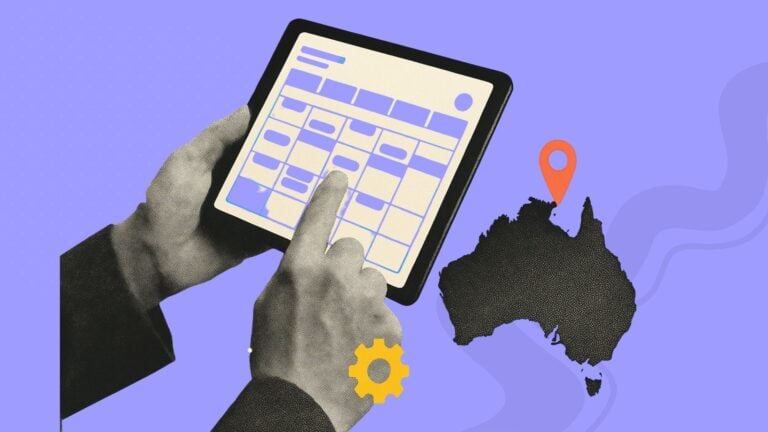Manual time tracking and scheduling methods waste time and cause errors.
The result? Missed deadlines, frustrated employees, and unhappy customers.
Thankfully, good workforce management apps automate these processes and reduce mistakes.
Below, I review 5 of the best workforce management software in Australia so you can make the switch today.
Our Top Picks
-
1
Best all-in-one workforce management software solution
-
2

Good for hospitality, retail, and healthcare
-
3

Good for all-in-one workforce + payroll management
Why trust us?
Our team of unbiased software reviewers follows strict editorial guidelines, and our methodology is clear and open to everyone.
See our complete methodology
How I Chose the Best Workforce Management Software in Australia
Here are the key features and tools I looked for in the best online workforce management software in Australia.
Core must-have features
- Time and attendance tracking: Let employees clock in and out of their shifts using shared kiosks or their own devices.
- Geolocation tracking: Monitor employees’ live locations while they’re on the clock or set geofences to prevent time theft.
- Digital timesheets: Convert time entries into timesheets for running accurate payroll.
- Job scheduling: Create and assign shifts with built-in breaks and overtime rules, notes, and more.
- Time off management: Let employees view leave balances and request time off, which you can approve or deny from your admin dashboard.
I also looked for these usability features:
- Mobile apps that teams on the move can use from anywhere.
- User-friendly design that’s accessible even to less tech-savvy users.
- Smart alerts for notifying workers about missed time entries, overtime violations, published employee schedules, and more.
Finally, some apps had these extras that took them from good to great:
- Task management tools to create, assign, and track tasks and subtasks.
- Digital forms and checklists to organise information in the format you need.
- In-app communication tools that help everyone stay connected regardless of their location.
The 5 Best Workforce Management Software in Australias of 2025
-
Connecteam — Best all-in-one workforce management software solution
Connecteam is the best all-in-one workforce management solution.
Why I chose Connecteam: Its clean and modern design, feature-rich mobile app, affordable pricing, and hands-on customer support make it ideal for businesses of all sizes.
Let’s take a closer look at Connecteam’s key workforce management tools.
Time and location tracking
The employee time clock lets workers punch in and out of their jobs from their desktops, tablets, mobile devices, or shared kiosks.
The platform also supports manual time tracking in case users forget to track their hours and lets employees tag billable and non-billable hours, so you can easily make sense of any discrepancies between timesheets and client invoices. You can track workers’ live locations while they’re on the clock to ensure everyone’s where they should be.
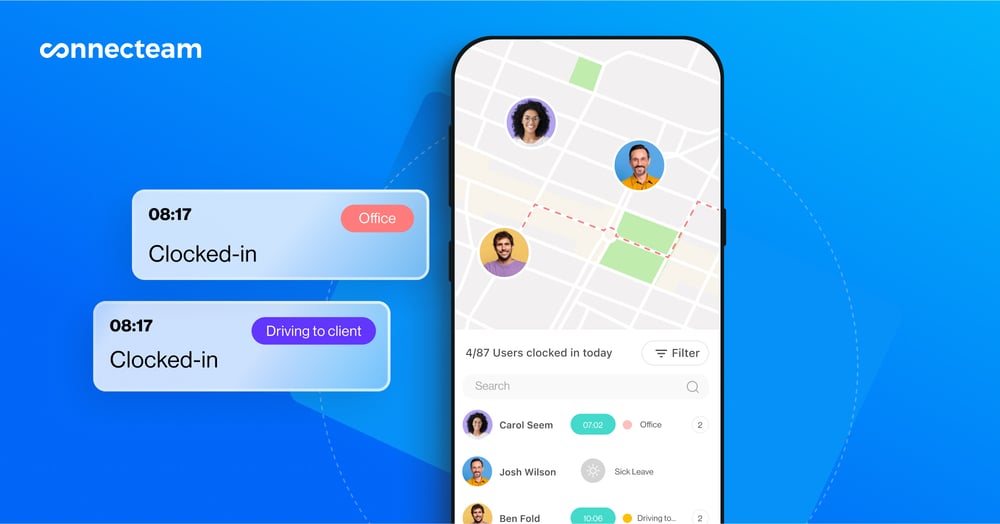
I like that you can set geofences, which prevent workers from tracking time unless they’re in a work zone—an excellent way to prevent time theft like buddy punching (where someone’s coworker clocks in for them). That’s not all—Connecteam lets you set overtime limits or mandate overtime approval, which is great for keeping labour costs in check.
Timesheets and payroll integrations
Connecteam automatically uses employees’ time logs to generate timesheets for payroll. You can view, edit and approve these in a few clicks from your admin dashboard before syncing them with one of several payroll solutions, including Xero, MYOB and more.
Automated job scheduling
Connecteam’s job scheduling tools let you create shifts from scratch, use pre-made templates, copy previous schedules, or import them from Excel. I also love that you can build recurring shifts for regular work.
Workers can also share their availability, locations, and shift preferences so you can account for these when assigning shifts.
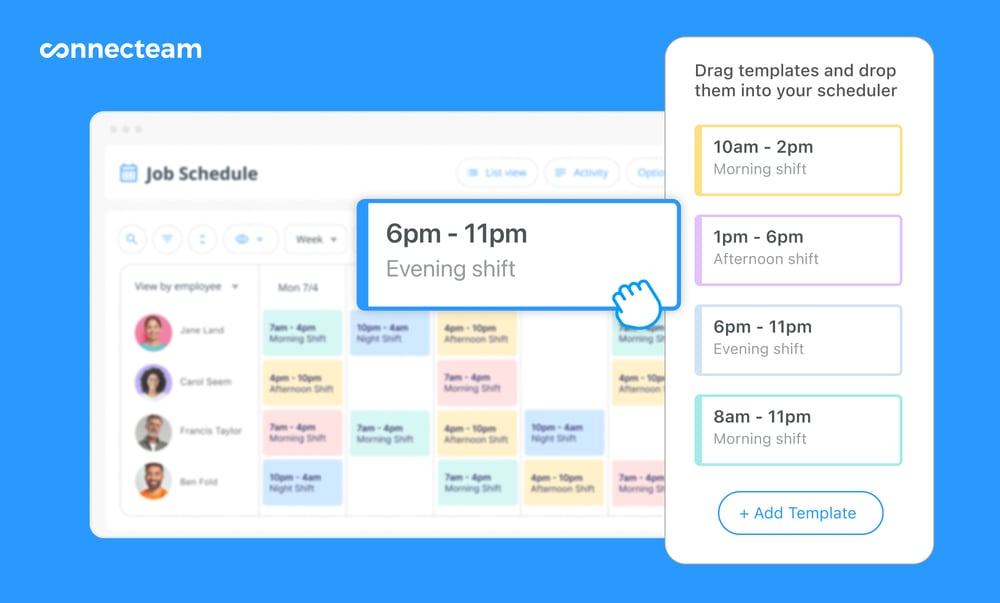
Alternatively, you can use my favourite—the auto-scheduler—which automatically assigns shifts based on all the above and even considers workers’ skills and qualifications.
You can build in rest breaks and meal times to help ensure you give workers the downtime they need and stay compliant with labour laws.
Furthermore, workers can pick from open shifts with or without approval (depending on your settings), and they can swap shifts easily in case of last-minute problems. I think this can save you hassle while empowering employees.
Time off management
You can use Connecteam’s time off management tools to create custom leave types—each with its own policy, including hours or days off, accruals, and carry-overs.
Workers can request time off from their apps. You can view their leave balances and approve or deny requests from your admin dashboard.
User-friendly tasks, forms, and checklists
Connecteam goes beyond just time tracking and job scheduling.
You can create tasks and subtasks and assign them to team members. Add notes, photos, videos, PDFs, due dates, and more so employees know exactly what they need to do and when. Additionally, employee task tracking shows you progress so you can send reminders to prevent delays and missed deadlines.
Meanwhile, digital forms and checklists are great for gathering information in a specific format—perfect for everything from incident reports and safety checklists to customer feedback forms.
Communications, training, HR, and more
Finally, Connecteam has some internal communication tools like an online team chat, company newsfeed, surveys, polls and a centralised knowledge base.
It also has training and development, document management, an employee directory and so much more—making it a one-stop shop for work management.
Key Features
- GPS time clock
- Digital timesheets
- Payroll reporting and integrations
- Automatic scheduler
- Task tracking
- Time off management
Pros
- Push notifications to send clock-in/out reminders
- Easy to navigate for everyone
- Fully mobile: Do anything from anywhere
- All-in-one—with task management, HR, and communication tools
Cons
- Doesn’t currently include accounting tools
Pricing
Free-for-life plan availablePremium plans start at $29/month for 30 users
14-day free trial, no credit card required
Start your free trial -

Deputy — Good for hospitality, retail, and healthcare
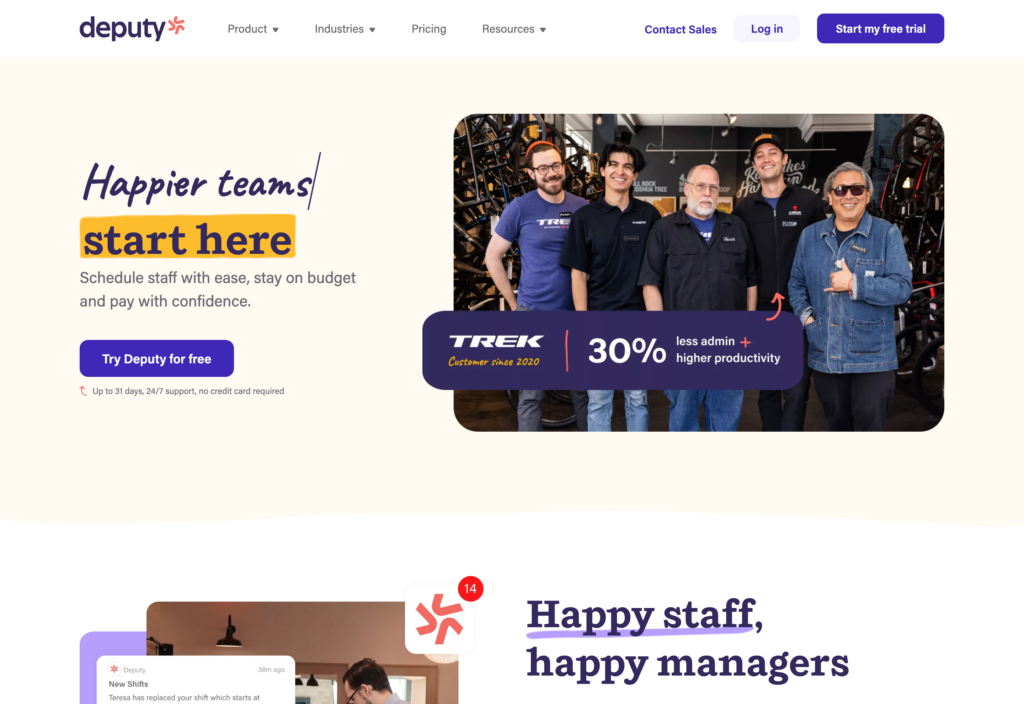
What’s new with Deputy
Deputy recently raised its base price from $4.50 per user/month to $5 per user/month. Existing clients are now being moved to the new pricing, significantly raising costs for many.
Deputy is a time tracking and employee scheduling platform.
Why I chose Deputy: Deputy made my list of secure workforce Management software for Australian businesses because it offers a wide range of workforce management tools, including internal communication features.
Let’s dive into Deputy’s workforce management features.
Job scheduling and time off management
I think Deputy’s scheduling feature is one of its key strengths. You can build rosters using drag-and-drop functionality or save time by copy-pasting previous shifts.
Even better, Deputy’s auto-scheduling tool does much of the heavy lifting by building shifts considering demand, sales trends, labour budgets and more—and assigning them to employees based on staff availability and qualifications. Plus, it accounts for labour law rules such as overtime limits and ensures shifts are fairly distributed.
That said, you can also assign shifts manually and mark some shifts as ‘open’, allowing workers to claim them. Additionally, Deputy lets workers request leave, and you can approve or deny requests from the app.

Deputy’s scheduler gives a clear overview of your staff and their scheduled work times. Time tracking, timesheets, and payroll
With Deputy, your team can clock in and out of shifts from any personal device or a shared kiosk. There’s also a geofencing feature that prevents clock-ins from outside of worksites, and an additional photo verification setting, which I think is great for preventing buddy punching.
When employees clock out, they can leave shift feedback and comments, which is great. That said, I wish they could mark comments as urgent or high priority to catch serious issues faster, for example, if equipment issues prevented them from doing their jobs.
Time entries flow into an online timesheet, which you can review and approve from your admin app. I like that Deputy automatically flags overtime on timesheets and shows you a breakdown of employee wages, including key award entitlements for each employee, such as penalty rates, overtime pay, and allowances.
Once timesheets are approved, you can integrate them with one of Deputy’s many payroll partners, including Xero.
Task management and team communications
Deputy’s task management tools let you create tasks and subtasks, set due dates, and use real-time tracking to monitor progress. I only wish it allowed for more customisation, such as adding images, videos, or detailed notes to tasks.
There’s also a newsfeed that works well for posting announcements and updates.
What users say about Deputy
Deputy never gives me any trouble with logging in. I am able to quickly check my schedule whenever I need to, even outside of Wi-Fi.
My least favourite feature of Deputy is that not only does it tell you when your shift starts, but sometimes sends multiple notifications up to 12hrs before!
Key Features
- Time tracking and timesheets
- Shift scheduling, including auto-scheduling
- Payroll integrations
- Task management
Pros
- Award interpretation built for Fair Work compliance
- Built-in geofencing and photo verification boost timesheet accuracy
Cons
- Must choose the Premium plan to get both time tracking and scheduling
- You can’t add images or videos to task notes
Pricing
Starts at $4.50/user/month Trial: Yes — 31-day Free Plan: No
-

Roubler — Good for all-in-one workforce + payroll management
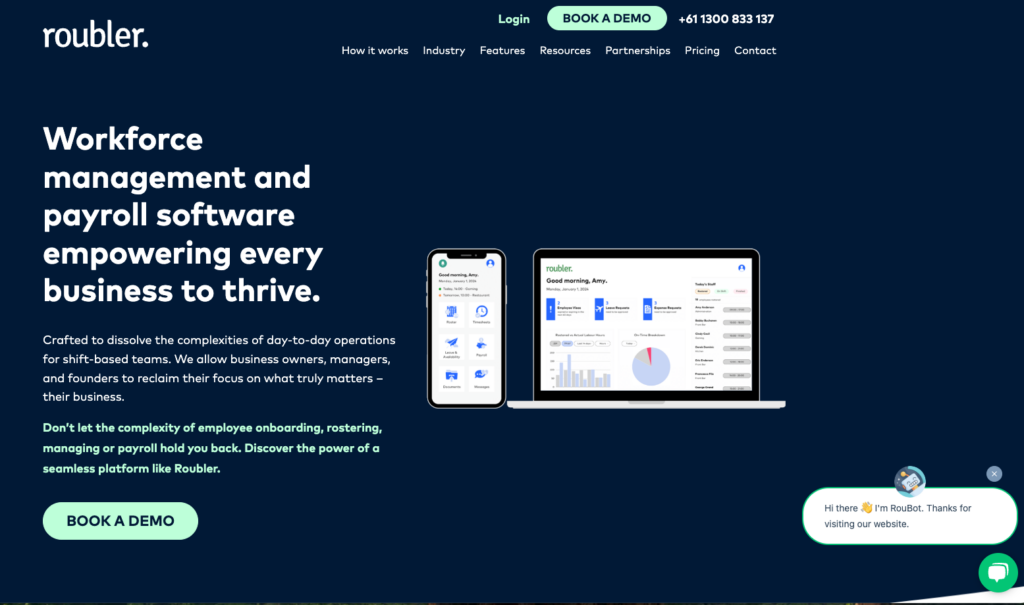
Roubler is a cloud-based workforce management solution with features for scheduling, time tracking, payroll, and onboarding.
Why I chose Roubler: The platform is configured to support large, Australia-based businesses and has a wide range of features, covering the entire employee lifecycle.
Here are Roubler’s key workforce management features.
Time tracking and payroll
What I liked most about Roubler was its time tracking flexibility. Employees can clock in and out of work or rest breaks from their mobile devices or a shared kiosk using a tablet. The facial recognition tool set up within the kiosk is also a great way to prevent buddy punching.
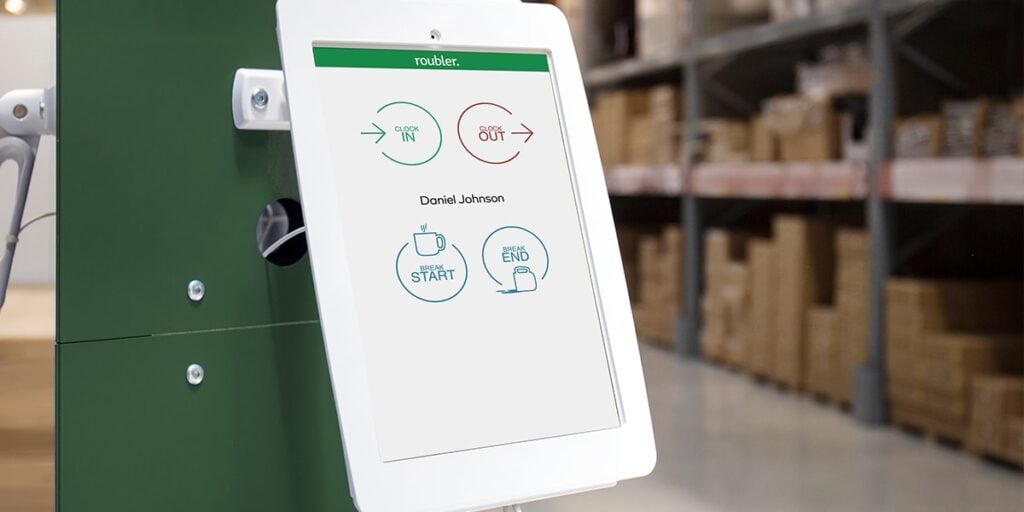
The Roubler kiosk app can be used by all employees at a worksite (Courtesy: Roubler) Timesheets are created automatically, so there’s no need for manual entries. Roubler includes built-in modern award interpretation to help ensure compliance when calculating pay rates.
While you can integrate timesheets with payroll providers like Xero and MYOB, Roubler doesn’t have the wide range of integrations I’ve seen with other platforms. That said, you can choose to use Roubler’s managed payroll service, which is great if you want the Roubler team to take care of payroll processing for you.
Scheduling and shift swaps
Roubler’s rostering tool also offers AI tools to build schedules based on staff availability, locations, leave, and compliance rules.
If you’re unhappy with the schedule, you can easily make edits using drag-and-drop functionality, even after you publish. And, employees can also swap shifts. In both cases, impacted employees are instantly notified via their apps.
That said, I found the scheduling tool lacked some finesse. For example, you can’t add shift-specific notes or tie tasks directly to the schedule. These are things other apps offer that help employees understand what’s expected.
What users say about Roubler
It is a good application for small and medium-sized companies to manage their employees more efficiently.
Holidays are a mess in Roubler. The support team cannot get it right. I have been trying to get this sorted for well over 2 years now and I have problems each month that I have to report to support.
Key Features
- Time tracking and timesheets
- Payroll integrations
- Managed payroll service
- Rostering
Pros
- Biometric facial verification prevents buddy punching
- Deep compliance features for AU award interpretation
Cons
- No easy way to link shifts to tasks or add custom shift notes
- Lack of many payroll integrations can be limiting
Pricing
Contact vendor for pricing Trial: No Free Plan: No
-

Tanda — Good for compliance-heavy industries
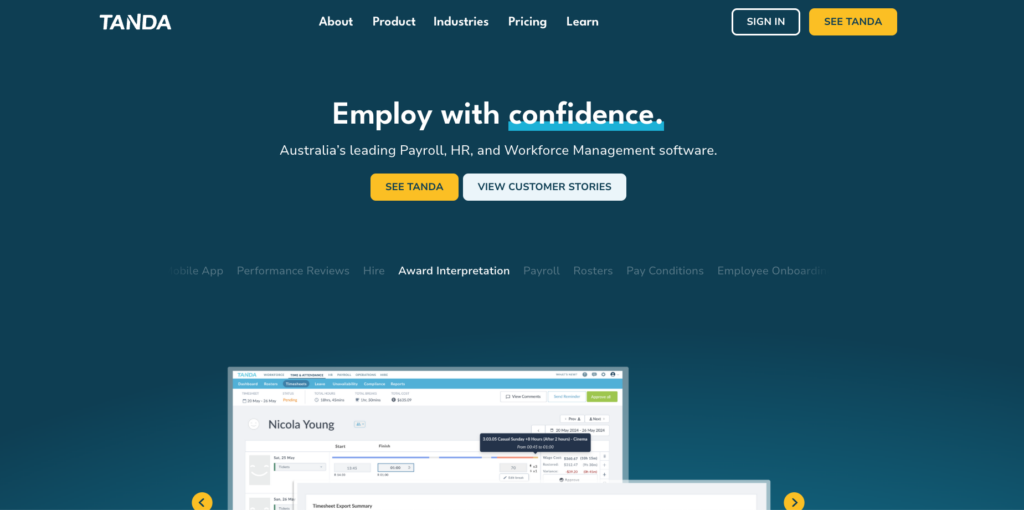
Tanda is a cloud-based software solution with a range of HR and workforce management tools.
Why I chose Tanda: While Tanda offers all the essential workforce management features, its compliance tools stand out to me.
Let’s look at Tanda’s core features and functionalities.
Time tracking and compliance
I found Tanda’s time clock straightforward to use. Workers can clock in using personal PINs, while you can monitor their GPS locations and mandate photos at clock-ins to prevent timesheet breaches.
Moreover, Tanda takes the headache out of compliance management. You can set rules for overtime, working hour limits, breaks, and more to ensure you’re adhering to labour regulations. It helpfully flags issues like overtime or missed breaks.
Further, Tanda’s built-in award interpretation engine is a real advantage for Australian companies managing shift workers under modern awards. It automatically applies the correct pay rates, entitlements, and terms.
Payroll and rostering
Tanda generates timesheets automatically from time clock data, and once approved, you can send these to payroll. That said, some users have reported hiccups with third-party payroll integrations like Xero.
On the upside, timesheets are generated automatically from time clock data, and any issues like overtime or missed breaks are flagged before syncing these with payroll.
With Tanda’s scheduler, you can create and assign shifts, add breaks, set hourly rates for different shifts, and more. There’s also a ‘quick build’ feature that lets you create schedules using templates to save time and effort for repeat rosters.
While Tanda offers auto-scheduling, I felt it wasn’t as comprehensive as other platforms. For example, while it assigns shifts based on factors like budgets and hours, it doesn’t account for scheduled time off, team member qualifications, or equal distribution of workload.
What users say about Tanda
Simple and easy to use. I like how the Dashboard gives you all an At-A-Glance view of important info.
There have been many glitches in the system with holiday accrual.
Key Features
- Time clock
- Built-in award interpretation engine
- Payroll integrations
- Rostering
Pros
- Excellent compliance and award interpretation
- HR features, including performance management
Cons
- Limited auto-scheduling and no shift-specific notes
- Issues reported with Xero integration
Pricing
Contact vendor for a quote Trial: Yes Free Plan: No
-

Humanforce — Good for large shift-based teams
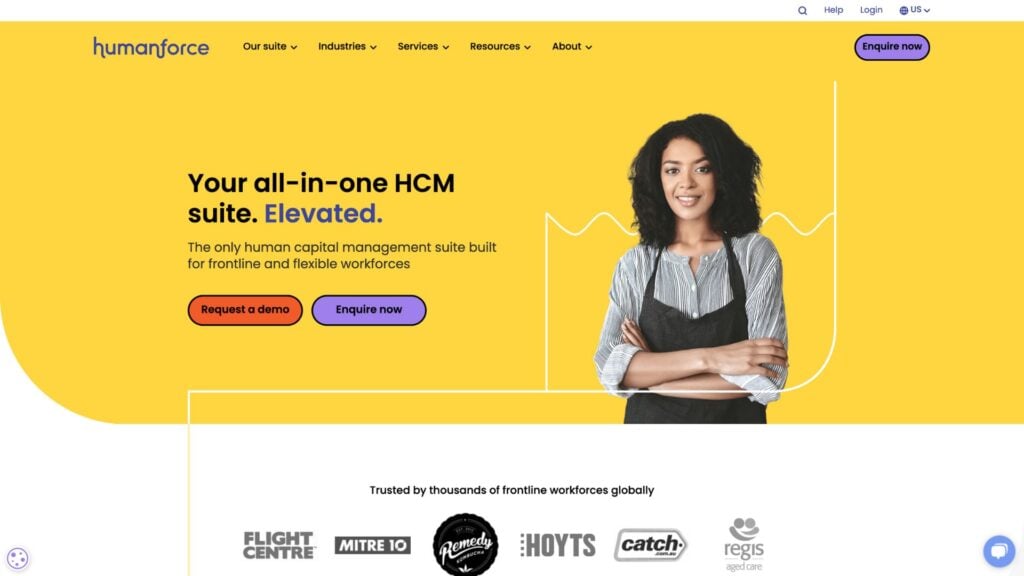
Humanforce is a workforce management solution with features for time tracking, scheduling, payroll, and more.
Why I chose Humanforce: In addition to workforce management, Humanforce also has a Human Capital Management (HCM) system, making it ideal for large businesses wanting an all-in-one solution.
Let’s explore Humanforce’s key features.
Scheduling and demand planning
Humanforce’s scheduling tools are comprehensive and easy to navigate. You can build one-off or recurring shifts, save schedules as templates, and auto-fill schedules based on availability, qualifications, and custom rules.
Employees can accept and reject shifts, pick open shifts, and swap shifts. I think this is especially clever for businesses that employ contractors and freelancers—you don’t need to spend time finding out who’s available for work when.
Once you’ve published schedules, you can view them with different filters—for instance, by role, department, or even employment type.
I also liked the demand planning feature, which uses a traffic light system to let you know if your demand is being met.
While I was largely impressed, Humanforce’s scheduling system has some drawbacks. For instance, employees can see unpublished shifts by default unless you change your settings. Plus, demand forecasting isn’t set up to pull demand data from third-party platforms, so forecasting is a manual exercise.
Time tracking and leave management
Team members can clock in and out through their mobile devices, web browsers, or shared kiosks. One standout for me was break management. You can set reminders or even enable auto-breaks to stay compliant and avoid missed breaks.
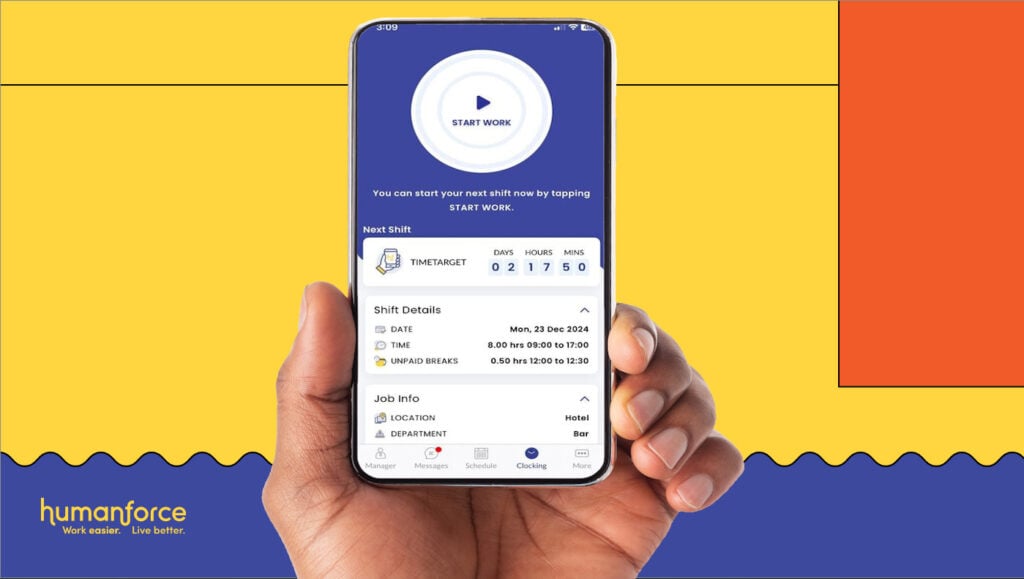
The Humanforce time clock lets you track overtime and breaks but lacks GPS breadcrumbs technology. (Photo ©Humanforce) Humanforce lets you use facial recognition or a ‘vein scanner’, which verifies identity by the pattern on one’s hand or fingers. Humanforce also offers GPS and geofencing features for additional vetting.
Once timesheets are generated, you can set Humanforce to auto-approve timesheets if they’re within a specified time window. I haven’t seen this option in other apps, so I was particularly impressed by it. Then, you can sync timesheets to payroll using Humanforce’s built-in payroll solution or third-party systems.
Leave management is another strong point. You can create customised leave types, tailor public holidays according to your location, add block-out periods (where employees are restricted from taking leave), and mandate minimum notice requirements.
I like these settings because they let you support workers’ time off while giving you enough time to cover their shifts. One downside? Setting up these configurations takes time.
Communication tools
Humanforce has an in-app chat that lets you interact with employees through direct messages and group chats. You can also share attachments and GIFs and see read receipts to ensure everyone reads important messages. But you can’t send voice messages or react to messages with thumbs-up or dislikes, making it less interactive.
Humanforce also lets you post on a digital notice board or send push notifications directly to employees’ phones.
What users say about Humanforce
It is very helpful for the managers or HRs to store and save the data of the employees in this software.
Customer service is not up to mark.
Key Features
- Scheduling
- Demand planning
- Time tracking
- Built-in payroll and payroll integrations
Pros
- Biometric facial verification prevents buddy punching
- Auto-approving timesheets can save time
Cons
- Employees can see unpublished shifts by default
- Lack of payroll integrations can be limiting
Pricing
Contact vendor for pricing Trial: No Free Plan: No
Compare the Best Workforce Management Software in Australias
| Topic |
 Start for free
Start for free
|

|

|

|

|
|---|---|---|---|---|---|
| Reviews |
4.8
|
4.6
|
4
|
4.4
|
4.2
|
| Pricing |
Starts at just $29/month for the first 30 users
|
Starts at $4.50/user/month
|
Contact vendor for pricing
|
Contact vendor for a quote
|
Contact vendor for pricing
|
| Free Trial |
yes
14-day
|
yes
31-day
|
no
|
yes
|
no
|
| Free Plan |
yes
Free Up to 10 users
|
no
|
no
|
no
|
no
|
| Use cases |
Best all-in-one workforce management software solution
|
Good for hospitality, retail, and healthcare
|
Good for all-in-one workforce + payroll management
|
Good for compliance-heavy industries
|
Good for large shift-based teams
|
| Available on |
What Is Workforce Management Software?
Workforce management software is a set of digital tools that help companies plan, track and manage their teams. It simplifies tasks like scheduling shifts, tracking employee hours and staying compliant with labour laws with features like time clocks, payroll integrations and auto-schedulers.
How Does Workforce Management Software Work?
Company admins (typically owners or HR) set up the system by inviting users, adding employee details, creating jobs, setting wages and compliance rules, integrating with payroll, and assigning permissions to managers.
From there, managers can build and publish schedules, check who’s clocked in and if they’re at the right locations, fill last-minute scheduling gaps, respond to time off requests, and communicate with their team. Once employee timesheets are ready, managers can review, edit, and approve them before running payroll.
Employees start their week by reviewing their schedules. They can clock in and out of shifts and breaks daily to ensure they’re paid accurately. Plus, they can use self-service tools to view and download payslips, swap shifts, request leave, and more.
The Benefits of Workforce Management Software
Online workforce management software for Australian businesses comes with several advantages.
Reduces administrative burden and human error
Workers can track hours, and you can create schedules, approve timesheets, and calculate payroll automatically—instead of using pen-and-paper systems or creating spreadsheets. This saves time and prevents mistakes like data entry or calculation errors.
Keeps you compliant
Secure workforce management software in Australia often offers built-in award interpretation, rest break tracking, overtime alerts, and custom leave management. These help you adhere to labour laws and reduce the risk of legal or financial penalties.
Strengthens accountability and reduces time theft
GPS tracking, geofencing, and biometric verification help you know who’s at their work sites, when they arrived, whether they took their required breaks, and more.
This helps you keep operations running like clockwork and prevents time theft, even when you’re physically away from your team members.
Boosts employee engagement and the employee experience
Most workforce management platforms provide employee self-service tools that let workers self-onboard, request leave, view their payslips, pick and swap shifts, and more. When employees feel empowered to manage their time and projects without layers of approval, they’re more likely to stay motivated and loyal to the company.
How Much Does Workforce Management Software Cost?
Secure workforce management software (Australia) varies in price points and structures. Most platforms require you to contact their sales teams for pricing.
As an example, Deputy’s plans start at USD 4.50/user/month (approx. AUD 6.75). However, Deputy has separate time tracking and scheduling plans, so if you want both, you’ll need the Premium plan, which is USD 6.00/user/month (approx. AUD 9.00).
Connecteam is both transparent and affordable. It starts at just USD 29/month for up to 30 users (approx. AUD 43.50). It also offers a free plan for small businesses and a 14-day free trial.
FAQs
Connecteam is the best online workforce management software in Australia. It offers tools for tracking time, scheduling shifts, creating and assigning tasks, communicating easily with your workforce from anywhere, and more.
Workforce forecasting is the process of predicting a company’s future staffing needs based on business goals, trends, and demand data to ensure the right talent is available when needed.
Most workforce management software comes at a steep price, but it can pay for itself by reducing labour costs, streamlining operations, and preventing mistakes. That said, some platforms, like Connecteam, have free plans and trials.
The Bottom Line on Workforce Management Software for Australia
Good workforce management tools help to run your business like a well-oiled machine and take the pain out of administrative tasks like time tracking, scheduling, and time off management. Ultimately, this boosts employee engagement, strengthens accountability, and keeps you compliant.
Among my top picks, Connecteam stands out as the best workforce management platform in Australia. In addition to its workforce management tools, it offers various other operations, communication, and HR management tools. Plus, it’s user-friendly and affordable.


